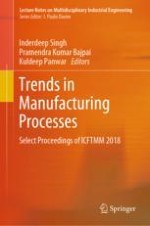2020 | Buch
Trends in Manufacturing Processes
Select Proceedings of ICFTMM 2018
herausgegeben von: Dr. Inderdeep Singh, Dr. Pramendra Kumar Bajpai, Dr. Kuldeep Panwar
Verlag: Springer Singapore
Buchreihe : Lecture Notes on Multidisciplinary Industrial Engineering
